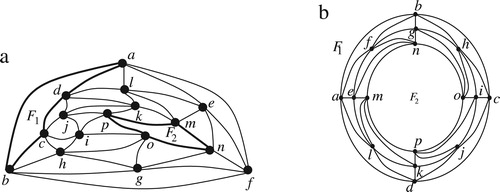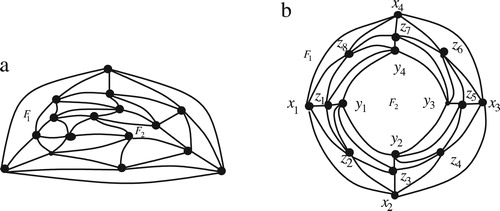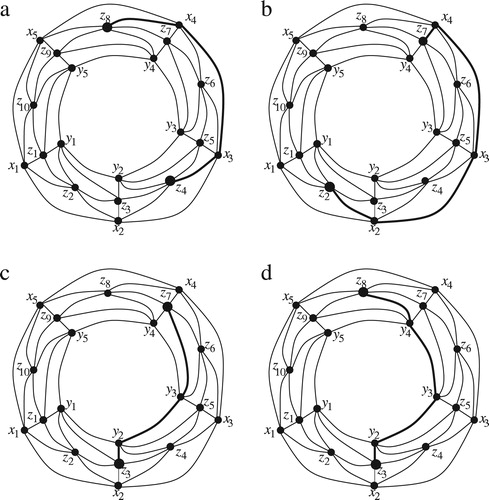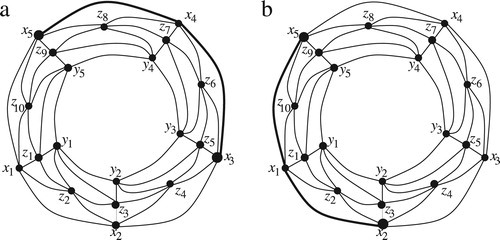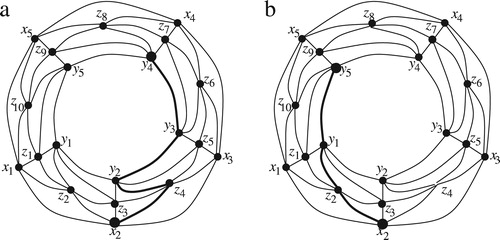Abstract
The class of doughnut graphs is a subclass of 5-connected planar graphs. It is known that a doughnut graph admits a straight-line grid drawing with linear area, the outerplanarity of a doughnut graph is 3, and a doughnut graph is -partitionable. In this paper we show that a doughnut graph exhibits a recursive structure. We also give an efficient algorithm for finding a shortest path between any pair of vertices in a doughnut graph. We also propose a nice application of a doughnut graph based on its properties.
1 Introduction
A five-connected planar graph is called a doughnut graph if
has an embedding
such that (a)
has two vertex-disjoint faces each of which has exactly
vertices,
, and all the other faces of
has exactly three vertices; and (b)
has the minimum number of vertices satisfying condition (a). (a) illustrates a doughnut graph where
and
are two vertex disjoint faces. Faces
and
are depicted by thick lines. The name of doughnut graph was chosen in [Citation1] for such a graph since the graph has a doughnut like embedding, as illustrated in (b). The class of doughnut graphs is an interesting class of graphs which was recently introduced in graph drawing literature for it’s beautiful area-efficient drawing properties [Citation1–Citation[2]Citation3]. A doughnut graph admits a straight-line grid drawing with linear area [Citation1,Citation3]. Any spanning subgraph of a doughnut graph also admits straight-line grid drawing with linear area [Citation2,Citation3]. The outerplanarity of this class is 3 [Citation3].
Given a graph ,
natural numbers
,
,
,
such that
, we wish to find a
-partition
of the vertex set
such that
and
induces a connected subgraph of
for each
. The problem of finding a
-partition of a given graph often appears in the load distribution among different power plants and the fault-tolerant routing of communication networks [Citation4,Citation5]. A doughnut graph is
-partitionable [Citation6].
A class of graph has recursive structure if every instance of it can be created by connecting the smaller instances of the same class of graphs. In this paper, we show that any instance of a doughnut graph can be constructed by connecting smaller instances of doughnut graphs. We show that one can find a shortest path between any pair of vertices and
of a doughnut graph
in
time where
is the length of shortest path between
and
by exploiting its beautiful structure. We study the other topological properties like degree, diameter, connectivity and fault tolerance. We show that it’s diameter is
. It has maximal fault tolerance, and has ring embedding since it is Hamilton-connected. One may explore the suitability of a doughnut graph as an interconnection network since some of its properties are similar to that of the graph classes usually used for interconnection networks.
The remainder of the paper is organized as follows. In Section 2, we give some definitions and preliminary results. Section 3 provides recursive structure of a doughnut graph. Finding a shortest path between any pair of vertices of doughnut graphs is presented in Section 4. Section 5 summarizes the topological properties of doughnut graphs. Finally Section 6 concludes the paper. An early version of this paper is presented at [Citation7].
2 Preliminaries
In this section we give some definitions.
Let be a connected simple graph with the vertex set
and the edge set
. Throughout the paper, we denote by
the number of vertices in
, that is,
, and denote by
the number of edges in
, that is,
. An edge joining the vertices
and
is denoted by
. The degree of a vertex
, denoted by
, is the number of edges incident to
in
. We denote by
the maximum of the degrees of all vertices in
.
is called r-regular if every vertex of
has degree
. We call a vertex
a neighbor of a vertex
in
if
has an edge
. The connectivity
of a graph
is the minimum number of vertices whose removal results in a disconnected graph or a single-vertex graph
.
is called
-
if
. A path in
is an ordered list of distinct vertices
such that
for all
. The vertices
and
are the end-vertices of the path
. The length of a path is one less than the number of vertices on the path. A path is called a u,v-path if its two end-vertices are
and
, respectively. The shortest path between two vertices
and
of
is a
-path of
with the least length. The distance from
to
, denoted by
, is the length of a shortest
-path. The diameter of
is
.
A graph is planar if it can be embedded in the plane so that no two edges intersect geometrically except at a vertex to which they are both incident. A plane graph is a planar graph with a fixed embedding. A plane graph divides the plane into connected regions called
. Each of the bounded regions is called an inner face and the unbounded region is called the outer face. Let
be all the vertices in the clockwise order on the contour of a face
in
. We often denote
by
. For a face
in
we denote by
the set of vertices of
on the boundary of face
. We call two faces
and
vertex-disjoint if
.
A maximal planar graph is one to which no edge can be added without losing planarity. Thus in any embedding of a maximal planar graph with
, each faces of
is triangulated, and hence an embedding of a maximal planar graph is a triangulated plane graph. It can be derived from the Euler’s formula for planar graphs that if
is a maximal planar graph with
vertices and
edges then
, for more details see [Citation8].
Let be a 5-connected planar graph, let
be any planar embedding of
and let
be an integer such that
. We call
a
-
graph if the following Conditions (
) and (
) hold: (
)
has two vertex-disjoint faces each of which has exactly
vertices, and all the other faces of
have exactly three vertices; and (
)
has the minimum number of vertices satisfying Condition (
). In general, we call a
-doughnut graph for
a doughnut graph. The following result is known for doughnut graphs [Citation1].
Lemma 1
Let be a
-doughnut graph. Then
is 5-regular and has exactly
vertices. Furthermore,
has three vertex-disjoint cycles
,
and
with
,
and
vertices, respectively, such that
.
For a cycle in a plane graph
, we denote by
the plane subgraph of
inside
excluding
. Let
,
and
be the three vertex-disjoint cycles of a
-doughnut graph
with
,
and
vertices, respectively, such that
. Then we call a planar embedding
of
a doughnut embedding of
if
is the outer face and
is an inner face of
,
contains
and
contains
. We call
the outer cycle,
the middle cycle and
the inner cycle of
. (b) illustrates the doughnut embedding of the doughnut graph in (a).
The following results on doughnut embeddings are known for doughnut graphs [Citation1].
Lemma 2
A -doughnut graph always has a doughnut embedding.
Lemma 3
Let be a doughnut embedding of a
-doughnut graph
and let
,
and
be the outer cycle, the middle cycle and the inner cycle of
, respectively. Then either condition (a) or condition (b) holds for any vertex
of
.
| (a) | The vertex | ||||
| (b) | The vertex | ||||
Before going further we need some definitions. Let be a doughnut embedding of
and let
,
and
be the outer cycle, middle cycle and the inner cycle of
, respectively. Let
be a vertex on
. Without loss of generality, by Lemma 3 we assume that
has exactly two consecutive neighbors on
. Let
and
be the two neighbors of
on
such that
is the counter clockwise next vertex to
on
. We call
the left neighbor of
on
and
the right neighbor of
on
. Similarly we define the left neighbor and the right neighbor of
on
if a vertex
on
has two neighbors on
. Let
,
be the vertices of
in counter clockwise order such that
has exactly one neighbor on
. Let
be the neighbor of
on
, and let
,
be the vertices of
in the counter clockwise order. Let
,
be the vertices on
in counter clockwise order such that
and
are the right neighbor and the left neighbor of
, respectively. (b) illustrates the labeling of vertices of a doughnut embedding
of
in (a) as mentioned above. In the rest of the paper, we consider a doughnut embedding
of a doughnut graph
such that the vertices of cycles
,
and
are labeled as mentioned above. We now have the following lemmas from [Citation1].
Lemma 4
Let be a
-doughnut graph and let
be a doughnut embedding of
. Let
be a vertex of
. Then the following conditions hold.
| (a) | The vertex | ||||
| (b) | The vertex | ||||
Lemma 5
Let be a
-doughnut graph and let
be a doughnut embedding of
. Let
be a vertex of
. Then
has exactly three neighbors
on
in a counter clockwise order if
, otherwise
has exactly three neighbors
,
,
on
in a counter clockwise order.
Lemma 6
Let be a
-doughnut graph and let
be a doughnut embedding of
. Let
be a vertex of
. Then
has exactly three neighbors
,
,
in a counter clockwise order if
, otherwise
has exactly three neighbors
,
,
on
in a counter clockwise order.
3 Recursive structure of doughnut graphs
A class of graphs has a recursive structure if every instance of it can be created by connecting the smaller instances of the same class of graphs. We now show that the doughnut graphs have a recursive structure. We now need some definitions. Let be a straight-line grid drawing of a
-doughnut graph
with linear area as illustrated in (a). We partition the edges of
as follows. The left partition consists of the edges—(i) (
), (ii) (
), (iii) (
), (iv)(
) and (v) (
); and the right partition consists of the edges—(i) (
), (ii) the edge between the two neighbors of
on
if
has two neighbors on
otherwise the edge between the two neighbors of
on
, (iii) the edge between the two neighbors of
on
if
has two neighbors on
otherwise the edge between the two neighbors of
on
, (iv) the edge between
and its right neighbor on
if
has two neighbors on
otherwise the edge between
and its left neighbor on
, and (v) the edge between
and its right neighbor on
if
has two neighbors on
otherwise the edge between
and its left neighbor on
. The graph
is divided into two connected components if we delete the edges of the left and the right partitions from
. We call the connected component that contains vertex
the top partition of edges and we call the connected component that contains vertex
the bottom partition of edges. (b) illustrates four partitions of edges (indicated by dotted lines) of a
-doughnut graph
in (a) where
.
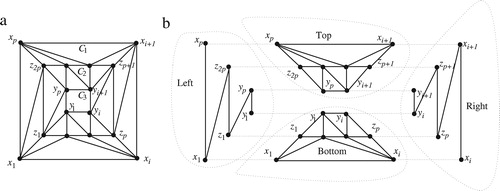
We now construct a ()-doughnut graph
from a
-doughnut graph
and a
-doughnut graph
. We first construct two graphs
and
from
and
, respectively, as follows. We partition the edges of
into left, right, top and bottom partitions. Then we identify the vertex
of the top partition to the vertex
of the right partition, the vertex
of the top partition to the vertex
of the right partition, and the vertex
of the top partition to the vertex
of the right partition. Thus we construct
from
. (c) illustrates
which is constructed from
in (a) where
. In case of construction of
, after partitioning (left, right, top, bottom) the edges of
we identify the vertex
of left partition to the vertex
of the bottom partition, vertex
of the left partition to the vertex
of the bottom partition, and the vertex
of left partition to the vertex
. (f) illustrates
which is constructed from
in (d) where
. We finally construct a
-doughnut graph
as follows. We identify the vertices
,
,
of
to the vertices of
,
,
of
, respectively; and identify the vertices of
,
,
of
to the vertices of
,
,
of
, respectively. Clearly the resulting graph
is a (
)-doughnut graph as illustrated in (h).
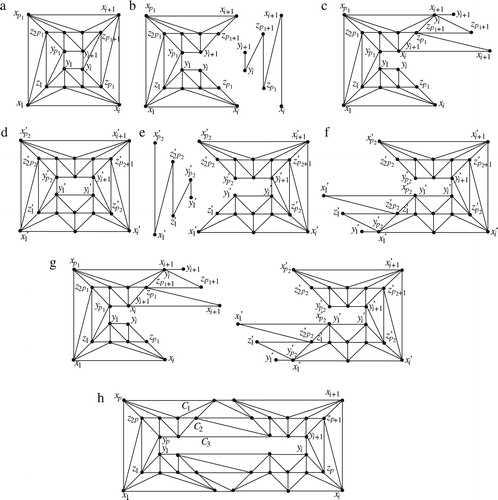
We thus have the following theorem.
Theorem 1
Let be a
-doughnut graph and let
be a
-doughnut graph. Then one can construct
-doughnut graph
from
and
.
4 Finding a shortest path
In this section, we present a simple efficient algorithm to find a shortest path between any pair of vertices. We have the following theorem.
Theorem 2
Let be a
-doughnut graph and let
be a doughnut embedding of
. Let
,
and
be the three vertex disjoint cycles of
such that
is the outer cycle,
is the middle cycle and
is the inner cycle. Then the shortest path between any pair of vertices
and
of
can be found in
time where
is the length of the shortest path between
and
.
Lemma 7
Let be a
-doughnut graph and let
be a doughnut embedding of
. Let
,
and
be the three vertex disjoint cycles of
such that
is the outer cycle,
is the middle cycle and
is the inner cycle. Then the shortest path between any two vertices on
(
) contains only the vertices of
(
), respectively.
Proof
We only prove for the case where both of the vertices are on since the proof is similar if both of the vertices are on
. Let
and
be two vertices of
. For contradiction, we assume that
is a shortest path between
and
which contains vertices other than the vertices of cycle
. Then (i)
would have a non-triangulated face other than
and
or (ii) a vertex of
would have degree more than five or (iii) the graph
would be non-planar, a contradiction to the properties of a doughnut graph. Therefore the shortest path between any two vertices of
contains only the vertices of
. ■
Lemma 8
Let be a
-doughnut graph and let
be a doughnut embedding of
. Let
,
and
be the outer, the middle and the inner cycle of
, respectively. Let
and
be two non-adjacent vertices on
and the length of the shorter (between clockwise and counter clockwise) path between them along
is
. Then the length of any path between
and
is at least
.
Proof
Without loss of generality we assume that and the shortest path between
and
along
is in the counter clockwise direction. We prove the claim by induction on
. Since
and
are non-adjacent, then
. The claim is true for
where
, and the shortest path between these two vertices has length
.
Assume that and the claim is true for all pairs of vertices of
with the shorter distance
between them along
. In this case
. Let
be any path between
and
. We now show that the length of
is at least
.
We first consider the case where contains some vertex
of cycle
such that
. If
is adjacent to
, then by induction hypothesis, the length of any path between
and
has length
and therefore the length of
is at least
. From the same line of reasoning, we can show that if
is adjacent to
, then the length of
is at least
. Thus we assume that
is adjacent to neither
nor
. Then from induction hypothesis, the length of any path between
and
is at least
and the length of any path between
and
is at least
. Therefore the length of
is at least
. Hence, no path containing vertices of the cycle
other than
and
has length less than
.
Thus we assume that does not contain any vertices of
other than
and
. Therefore there are only two different paths to consider for each pair of vertices
and
, one containing only vertices of
and the other containing only vertices of
other than
and
. If
contains only the vertices of
other than
and
, then by Lemma 4, the rightmost (or only) neighbor of
and the leftmost (or only) neighbor of
on
are
and
, respectively. Therefore the length of
is at least
as illustrated in (a) and (b). On the other hand, if
contains only the vertices of
other than
and
, then by Lemma 4, the rightmost (or only) neighbor of
and the leftmost (or only) neighbor of
on
are
and
, respectively. Therefore the length of
is at least
as illustrated in (c) and (d). ■
We are now ready to prove Theorem 2.
Proof
The vertices of lie on three vertex disjoint cycles
,
and
where
is the outer cycle,
is the middle cycle and
is the inner cycle. We have four cases to consider.
Case 1: Both and
are either on
or on
.
Without loss of generality, we assume that both the and
are on
, since the case is similar where both of
and
are on
. Let
and
. Without loss of generality, we may assume that
. Let us take the path
,
,
,
if
otherwise
,
,
,
. By Lemma 7,
is the shortest path between
and
. illustrates the case where (i)
and
, and (ii)
and
.
Case 2: Both and
are on
.
We assume that and
, respectively. The shortest path between
and
consists of edge
if
and
are adjacent. We thus assume that
and
are not adjacent. Without loss of generality, we also assume that
. We now define a path between
and
. We have the following four types of paths to consider — (i) we take path
if both
and
are even; (ii) we take path
if both
and
are odd; (iii) we take path
if
is even and
is odd; (iv) we take path
if
is odd and
is even. The paths of Types (i), (iii) and (iv) contain vertices of
and
. By Lemma 4,
and
are neighbors of
and by Lemma 5,
is a neighbor of
and
. The path of Type (ii) contains vertices of
and
. By Lemma 4,
is a neighbor of
and by Lemma 6,
is a neighbor of
. It is easy to verify that each of the paths
as mentioned above has length
and by Lemma 8, these paths are the shortest paths between
and
.
Case 3: One of and
is on
, and the other one is on
or
.
We assume that is on
and the
is on
. Let
and
. We also assume that
. For odd value of
, we take
,
,
if
otherwise
,
,
. For even value of
, we take
,
,
if
otherwise
,
,
. Each of the paths
contain vertices of
and
. By Lemma 4,
and
are neighbors of
. We can prove that both of the paths are the shortest path since each of them are the subpaths of the shortest path of Subcase 2(b) and the length of the shortest path between
and
is
. (a) illustrates an example where
and
. The shortest path
,
,
,
. (b) illustrates an example where
and
. The shortest path
,
,
,
.
Case 4: One of and
is on
, and the other one is on
.
We assume that is on
and
is on
. Let
and
. Without loss of generality, we assume that
. Let us take the path
,
,
,
if
otherwise let us take path
,
,
,
. Each of the paths
contain vertices of
,
and
. By Lemma 5,
and
are neighbors of
, and by Lemma 4,
is a neighbor of
and
is a neighbor of
. We now prove that
is the shortest path between
and
. We prove only for the case where
is to the counter clockwise direction of
. Let
. Since the length of
is
, it is sufficient to prove that the length of the shortest path between
and
is at least
. The claim is obvious for
. We thus assume that
and the claim is true for any value of
. Assume for contradiction that there is a shortest path
between
and
with length less than
. Since
is to counter clockwise direction from
, the second vertex of the shortest path
is either
or
. If
is the second vertex then by induction hypothesis, the shortest path between
and
has length
and the length of
is at least
which contradicts our assumption. Thus we assume that the second vertex is
. Since
contains the shortest path between
and
by Case 3, the length of
cannot be less than
in this case also. (a) illustrates an example where
and
. The shortest path
,
,
,
,
. (b) illustrates an example where
and
. The shortest path
,
,
,
.
Thus we can find a shortest path between any pair of vertices of a doughnut graph. One can see that the shortest path between any pair of vertices can be found in time where
is the length of the shortest path between
and
. ■
5 Topological properties of doughnut graphs
Let be a
-doughnut graph. By Lemma 1, the number of vertices of
is
where
is an integer. A
-doughnut graph is maximal fault tolerant since it is 5-regular by Lemma 1. By Lemma 2, every
-doughnut graph
has a doughnut embedding
where vertices of
lie on three vertex disjoint cycles
,
and
such that
is the outer cycle containing
vertices,
is the middle cycle containing
vertices and
is the inner cycle containing
vertices. Then one can easily see that the diameter of a
-doughnut graph is
. Moreover, a doughnut graph admits a ring embedding since a doughnut graph is Hamilton-connected [Citation6].
6 Conclusion
In this paper, we have studied recursive structure of doughnut graphs. We have proposed an efficient algorithm to find shortest path between any pair of vertices which exploit the structure of the graph. We have also found that doughnut graph has smaller diameter, higher degree and connectivity, maximal fault tolerance and ring embedding. There are several parameters like connectivity, degree, diameter, symmetry and fault tolerance which are considered for building interconnection networks [Citation9]. presents the topological comparison of various Cayley graphs, which are widely used as interconnection networks, with doughnut graphs. The table shows that topological properties of doughnut graphs are very much similar to interconnection networks. One of the limitation is the diameter which is linear but the coefficient is . We may have an efficient routing scheme using shortest path finding algorithm. We can have a scalable interconnection network using doughnut graphs since the degree of a vertex of a doughnut graph does not change with the size of the graph. This is also important for VLSI implementation point of view as well as applications where the computing nodes in an interconnection networks only have fixed number of I/O ports. Thus doughnut graphs may find nice applications as interconnection networks.
Table 1 Topological comparison of doughnut graphs with various Cayley graphs.
Notes
Peer review under responsibility of Kalasalingam University.
References
- M.R.KarimM.S.RahmanStraight-line grid drawings of planar graphs with linear areaProceedings of Asia-Pacific Symposium on Visualisation 20072007IEEE109112
- M.R.KarimM.S.RahmanFour-connected spanning subgraphs of doughnut graphsProceedings of Workshop on Algorithms and Computation, 2008 Lect. Notes in Computer Science 4931 (2008) Springer. 132–143.
- M.R.KarimM.S.RahmanOn a class of planar graphs with straight-line grid drawings on linear areaJ. Graph Algorithms Appl.1322009153177
- Shin-ichiNakanoMd. SaidurRahmanTakaoNishizekiA linear-time algorithm for four-partitioning four-connected planar graphsInform. Process. Lett.621997315322
- SayakaNagaiShin-ichiNakanoA linear-time algorithm for five-partitioning five-connected internally triangulated plane graphsIEICE Trans. Fundam.E84-A9200123302337
- M.R.KarimK.M.NahiduzamanM.S.RahmanA linear-time algorithm for -partitioning doughnut graphsINFOCOMP812009813
- M.R.KarimM.J.AlamM.S.RahmanOn some properties of doughnut graphs (Extended Abstract)Proceedings of International Workshop on Combinatorial Algorithms, 2012 Lect. Notes in Computer Science 7643 (2012) Springer. 60–64.
- T.NishizekiM.S.RahmanPlanar Graph Drawing2004World ScientificSingapore
- J.XuTopological Structure and Analysis of Interconnection Networks2001Kluwer Academic PublishersDordrecht
- F.P.PreparataJ.VuilleminThe cube-connected-cycles: A versatile network for parallel computationCommun. ACM241981300309
- F.T.LeightonIntroduction to Parallel Algorithms and Architectures: Arrays-trees-hypercubes1992Morgan Kaufmann Publishers, Inc.San Mateo
- L.BhuyanD.P.AgarwalGeneralized hypercube and hyperbus structure for a computer networkIEEE Trans. Comput.331984323333

